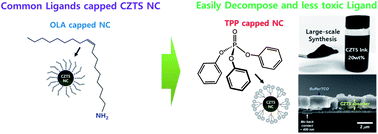Highly concentrated synthesis of copper-zinc-tin-sulfide nanocrystals with easily decomposable capping molecules for printed photovoltaic applications†
Abstract
Among various candidate materials, Cu2ZnSnS4 (CZTS) is a promising earth-abundant semiconductor for low-cost thin film solar cells. We report a facile, less toxic, highly concentrated synthetic method utilizing the heretofore unrecognized, easily decomposable capping ligand of triphenylphosphate, where phase-pure, single-crystalline, and well-dispersed colloidal CZTS nanocrystals were obtained. The favorable influence of the easily decomposable capping ligand on the microstructural evolution of device-quality CZTS absorber layers was clarified based on a comparative study with commonly used oleylamine-capped CZTS nanoparticles. The resulting CZTS nanoparticles enabled us to produce a dense and crack-free absorbing layer through annealing under a N2 + H2S (4%) atmosphere, demonstrating a solar cell with an efficiency of 3.6% under AM 1.5 illumination.


 Please wait while we load your content...
Please wait while we load your content...